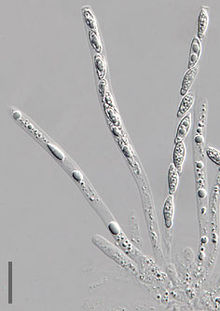Ascus
The ascus (plural: Asci, translated: tube) is the characteristic and (for the scientific name Ascomycota) eponymous reproductive organ of the ascomycota .
It is a sack-like and elongated container in which the reduction division of the fungi takes place and in which the haploid Asco spores arise, which in turn represent the distribution form in some types of fungus. Sporulation is often necessary to generate offspring quickly, for example to overcome periods of hunger.
Ascus classification
The shape of the ascus also plays a role in the classification of the ashes. There are basically four types:
- A unit unique operculator Ascus has a built-in "lid", the operculum in the apical apparatus , which has a built-in weak point at which it breaks open after the spores have matured and releases them in this way. Unitunikat-operculate asci occur only in the ascocarps called apothecia , for example in morels .
- A unitary inoperculum ascus, on the other hand, has no operculum. In its place there is an elastic ring that works like a pressure valve . When ripe, it expands briefly and lets the spores shoot out. This type is found in both apothecia and perithecia . One example species is the gold mold shown ( Hypomyces chrysospermus ).
- A bit unique Ascus is characterized by the fact that it is surrounded by a double wall. This consists of a thin, brittle outer shell and a thick, elastic inner wall. As soon as the spores are ripe, the shell splices open so that the inner wall can absorb water. As a result, it begins to expand, together with the spores it contains, until it rises above the rest of the ascocarp, so that the spores can move freely from the fruiting body of the fungus into the free air flow. Bitunicate Asci occur exclusively in pseudothekia and can be found, for example, in apple scab ( Venturia inaequalis ) and horse chestnut leaf tan ( Guignardia aesculi ).
- The prototunicate asci , which are usually spherical, have no active release mechanism at all . With them, the mature ascus wall either simply dissolves so that the spores can swell out, or it is broken open by external influences such as animals. Prototunikate Asci can be found in perithekia as well as in Kleistothekia, for example in the blue fungi ( Ophiostoma ). Since it is more of a collective term for asci that do not belong to the other three types, it is considered likely that they have developed independently from unit unique asci several times.
literature
- Hans Otto Schwantes: Biology of the mushrooms. An introduction to applied mycology (= university paperbacks . Volume 1871 ). Ulmer, Stuttgart 1996, ISBN 3-8252-1871-6 .


